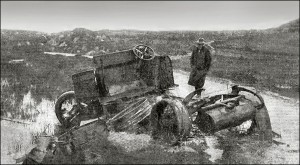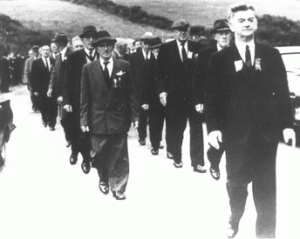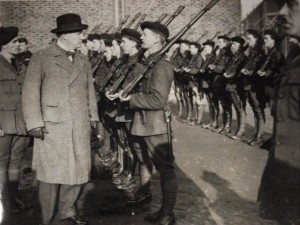Opinion: Commemorating Kilmichael

Pádraig Óg Ó Ruairc on the pitfalls of commemorating the Kilmichael ambush.
The Southern Star newspaper recently reported (3rd August 2013) that Cork County Council has approved a joint application by two local heritage groups to redevelop the site of the Kilmichael Ambush. The application includes plans to commemorate the RIC Auxiliaries killed in the ambush and has been described as a “suitable commemoration for both [the] IRA Volunteers and [the] Auxiliaries.”
The idea of developing Kilmichael into a heritage site and tourist attraction has been widely welcomed. However the idea that this development will include a formal commemoration of the Auxiliaries has met with strong opposition. This controversy has arisen at the beginning of the ‘Decade of Centenaries’ and raises important questions about the nature and politics of commemoration and who and what we commemorate.
Historical commemoration is essentially a political act. Communities make decisions on who to commemorate based on their current values and political and social outlook.
Historical commemoration is essentially a political act. Communities make decisions on who to commemorate based on their current values and political and social outlook. Recently commemorations were held to mark the centenary of the ‘Votes for Women Campaign’ and the struggle for women’s rights. Events were held throughout Ireland and Britain marking the anniversary of the campaign and celebrating the lives of famous Suffragettes.
However there were no commemorations for the ‘Women’s National Anti-Suffrage League’, an organisation which campaigned on the basis that women did not deserve the vote. The reason why the Anti-Suffragettes have been ignored is both obvious and deliberate. Today our society accepts that women are entitled to the same rights as men. With the benefit of hindsight those organising commemorations know that the Suffragette’s cause was a just one. Thus it is accepted that the memory of those who fought to secure women’s suffrage should be celebrated and that their opponents should not be afforded the same status.
A similar situation arises with the centenary of the 1913 Dublin Lockout. Commemorations are being held throughout the capital to celebrate Jim Larkin, the striking workers, the Citizen Army and the struggle of Dublin’s poor for decent working and living conditions. Unsurprisingly, there are no plans to erect plaques in Dublin to William Martin Murphy and the Employers Federation. Nor are there plans to honour the DMP Constables who suppressed the strike with brute force and killed a number of the strikers in the process. The reason Murphy and his supporters will not be honoured in Dublin is that modern Irish society now accepts that workers have a fundamental right to join a trade union. Consequently it is generally agreed that the workers who went on strike in the capital one hundred years ago to secure that right were justified in their actions.
Commemorating the War of Independence

The same partisan approach was traditionally adopted in the south of Ireland regarding commemoration of the Kilmichael Ambush and other actions of the War of Independence. This was partially because the southern Irish state and many of its institutions, including Dáil Éireann, the Irish Defence Forces and An Garda Sióchana, owe their origins to the Republican movement of 1919 to 1921.
Irish Republicans had won an overwhelming majority of Irish seats in the 1918 general election, and felt this gave them a democratic mandate to pursue the Irish people’s claim to independence. The traditional view of the conflict in the south of Ireland was that when the Republicans launched their military campaign to establish an independent republic they were justified in doing so, and fought a largely ‘clean’ campaign against the British Forces.
Critics of the Republican military campaign waged during the War of Independence used this debate to call for a reassessment of the role played by the RIC, Black and Tans, and other British forces in the conflict.
Of course the conduct of the war was far more complex than this traditional view allowed – but the historian Peter Hart’s claims about the IRA’s ‘dirty war’ went to the opposite extreme and were in many cases exaggerated or oversimplified. Hart’s claims about the execution of captured Auxiliaries at Kilmichael, and his allegations of IRA sectarianism in Cork during the War of Independence, whether justified or not, severely damaged the reputation of the republican combatants and played an important part in the ‘Revisionist vs Anti-Revisionist’ historical debates of recent decades.
Critics of the military campaign waged by Republicans during the War of Independence used this debate to call for a reassessment of the role played by the RIC, Black and Tans, and other British forces in the conflict.
Remembering the RIC and Auxiliaries

Given the nature of the debate about the morality of the Republican actions it was inevitable that there would also be calls to reassess the way the conflict is commemorated nationally. The idea that those who fought to prevent Irish independence should be formally commemorated in the south of Ireland first received serious attention when journalist Chris Ryder, author of the book ‘The RUC A Force Under Fire’ wrote an opinion piece for the Irish Times in August 2011.
Ryder suggested there should be a formal commemoration of the Royal Irish Constabulary in the Irish Republic. Furthermore he suggested that this commemoration should include the RIC Constables, Black and Tans and RIC Auxiliaries killed during the War of Independence. One year later a commemoration on the lines suggested by Ryder was held in Glasnevin Cemetery, Dublin. (For more on this see my previous piece on this on The Irish Story, here)
Some have suggested there should be a formal commemoration of the Royal Irish Constabulary in the Irish Republic
The organisers of this event expressed their disappointment that it had not been made an official Irish state commemoration. However, had the ceremony been afforded such a status, it would have resulted in a ridiculous situation whereby the Irish state undermined it’s own legitimacy by paying homage to those who fought to prevent the establishment of the state!
As part of the proposed redevelopment of the Kilmichael ambush site an application has been made for €100,000 in public funds to finance the project. Surely it would be wrong for state bodies to spend public funds commemorating those who fought to prevent Irish independence, and deny the Irish people what we now accept are their basic democratic rights?
Whilst citizens in the south of Ireland have always been proud of their country’s independence, the economic collapse has refocused southern Irish minds on the importance of fiscal independence. Autonomy, independence and sovereignty have now become political buzz-words employed by Irish politicians who repeatedly stress how important it is that we reclaim these rights. If we really hold these freedoms to be so important why would we commemorate and celebrate the memory of members of the British forces who sought to deny them to our forefathers?
If we really hold these freedoms to be so important why would we commemorate and celebrate the memory of members of the British forces who sought to deny them to our forefathers?
It would of course be natural for British people to want to commemorate those who fought to keep Ireland within the United Kingdom and the British Empire. However few Britons seem eager to do so. In my experience, the British public, even those with strong military connections, are not especially proud of the role their forces played during the Irish War of Independence. British history books and school text books either gloss over the ‘Irish question’ or ignore it completely.
British military museums are equally evasive. Local regimental museums omit any reference to the war in Ireland, though a few will mention in passing the more recent ‘troubles’. Even the Imperial War Museum, which has an exhibit on the 1916 Rising, does not mention the War of Independence. British memorials which list the names of those killed in ‘peace time’ conflicts do not mention British troops killed in Ireland between 1919 and 1921. Interestingly, British troops killed in Ireland at the time are far more likely to be commemorated by Ulster loyalists than by the populace in Britain.
British forces’ record in Ireland 1919-1921
The reason why the British are reluctant to acknowledge or commemorate British troops killed in the Irish War of Independence is because of the numerous atrocities, attacks on civilians and reprisal killings committed by their troops. The record of the RIC’s Auxiliary Division is amongst the worst of any British military, police or paramilitary unit in Ireland.
The reason why the British are reluctant to acknowledge or commemorate British troops killed in the Irish War of Independence is because of the numerous atrocities, attacks on civilians and reprisal killings committed by their troops.
The Auxiliaries were involved in the ‘Bloody Sunday’ massacre at Croke Park at which thirteen innocent civilians were killed. The same day the Auxiliaries killed another three unarmed prisoners (two IRA and 1 civilian) at Dublin Castle. The following week the Auxiliaries in Galway captured, tortured and killed two brothers who were in the IRA; Pat and Harry Loughnane. When their burned and mutilated bodies were eventually found they were scarcely recognisable. Pat’s wrists, legs and arms were broken, his skull was fractured and his torso had been mutilated with a blade. Harry’s body was missing two fingers, his right arm was broken and nothing was left of his face except his chin and lips. The same month the Auxiliaries in Galway also abducted, killed, and secretly buried Fr. Michael Griffin a Catholic priest who held republican sympathies.
In December 1920 the Auxiliaries were responsible for the ‘Burning of Cork’ which caused £3 million worth of damage, destroyed 5 acres of property, saw the assassination of two unarmed republicans who were asleep in their beds and left at least 2,000 workers unemployed. The Auxiliaries were also involved in a covert British campaign of reprisal killings and the assassination of elected officials. In March 1920 the Mayor of Limerick, George Clancy, and his predecessor, the former Mayor, Michael O’Callaghan, were assassinated in their homes by Auxiliaries under the command of Section Leader George Nathan. ‘C Company’, the unit of the Auxiliaries attacked at Kilmichael were also responsible for a number of reprisal killings.
Just two weeks before the Kilmichael Ambush a member of C Company shot dead an innocent civilian named Jim Lehane at Ballyvourney. Later that night the killer got drunk in a local pub and boasted he ‘got the bastard’ and that shooting the Irish was the ‘one way of teaching them manners’. The Auxiliary responsible for Lehane’s killing was Cadet Gutherie, the same Auxiliary who escaped the Kilmichael Ambush only to be killed by the IRA a short time later.
In December 1920 a member of C Company shot Cannon Magner, a 73 year old Catholic priest, and his travelling companion Timothy Crowley, killing them both in cold blood without and provocation. Discipline within the Auxiliary Division eventually became so bad, and reprisal killings so common, that Brigadier General Crozier resigned as head of the force stating that he ‘could not go on leading a drunken and insubordinate body of men.’
The excesses of the Auxiliaries, the Black and Tans and the other British forces in Ireland ultimately proved counterproductive. The British public became increasingly disturbed at the outrages committed in their name. Ultimately this was a decisive factor in the British Government’s decision to begin political negotiations with Irish Republicans that led to the Anglo-Irish Truce of 11 July 1921.
It is interesting that people with southern Republican and Irish Nationalist backgrounds have been prominent in organising commemorations of the British troops killed in the War of Independence. This may be the result of post-peace process politics and the idea of ‘parity of esteem’ between warring political traditions. Or, alternatively it may spring from the “delusional” and “warped sense of nationhood” that Geraldine Moane, Senior Lecturer in Psychology at UCD, recently stated was a legacy of Ireland’s experience of colonialism.
Regardless of its origins, if Irish people begin commemorating those who fought to deny our forefathers the rights we now cherish, surely it will be ‘political correctness’ taken a step too far? If we stop asking what people were fighting for and if their actions were justified, then we will have reduced our history to a bland equation where there is no context, sense of morality, or concept of justice and right or wrong.
Irish people seem to be alone in commemorating their forefather’s enemies. The British do not commemorate the Germans, Turks and Irish rebels killed by the British army during their First World War at their Remembrance Day ceremonies – nor do the Germans, Turks and Irish expect them to. The Americans do not erect monuments to the British troops killed by Washington’s army.
The British soldiers killed in the Indian Mutiny are not celebrated by Indians. Those killed fighting the Mau Mau are not commemorated by the Kenyans. In fact, it is more commonplace for the British Government to make historical apologies (for all they are worth) for their past colonial misdeeds. This was most recently demonstrated by the recent apology to the Kikuyu in Kenya. However, in Ireland we seem to be intent on moving in the opposite direction.
The Kilmichael memorial and development
We cannot ignore the presence of the Auxiliaries at Kilmichael or pretend that the ambush was a bloodless affair. But there is a significant difference between recalling someone’s place in history and celebrating them through commemoration. If the Auxiliaries killed at Kilmichael were named on an information panel with context being provided by an outline of the force’s history and its role in Ireland, it is likely that the current controversy would not have arisen.
We cannot ignore the presence of the Auxiliaries at Kilmichael or pretend that the ambush was a bloodless affair.
A member of the Heritage Council writing in support of the Kilmichael development stated, “I think there is a need to achieve a balanced interpretation of what happened at Kilmichael that reflects modern scholarship of the ambush.” This sounds like a good idea at first, but the problem, as recent debate about Peter Hart’s work has demonstrated, is that modern scholars are not in agreement about what happened at Kilmichael. The significance of the ambush and the debates about the nature of the War of Independence are far too nuanced and complex to be adequately explained in a few lines on a memorial plaque.
If those intent on developing the ambush site really want foster a deeper understanding of our history, the €100,000 in funds they have earmarked for the scheme would be far better spent renovating a farmhouse near Kilmichael as a museum or interpretive centre. This would give greater scope to explore the history of the ambush and its related controversies. A visitor centre would also serve as a space where artefacts from the conflict could be preserved and debates could be held. If such a centre was established within walking distance of the ambush site, visitors could be taken to view the battlefield without spoiling its integrity.
The €100,000 in funds earmarked for a new memorial to the Auxiliary dead at Kilmichael would be far better spent renovating a farmhouse near Kilmichael as a museum or interpretive centre.
As well as allowing a more detailed exploration of the history of the war, a museum would benefit the local economy, creating seasonal jobs and sustainable tourism – benefits which the proposed re-development of the Kilmichael site is unlikely to bring. If anyone doubts the viability of this suggestion I would invite them to visit the Michael Collins Centre in West Cork or to look at the plans for the new Michael Collins Museum in Clonakilty.
Now that we are in the ‘Decade of Centenaries’ we need to have serious debates about the Irish Revolution of 1913 – 23. We need to ask ourselves hard questions, and be prepared, when faced with new evidence, to abandon comfortable fables in favour of difficult facts. We also need to remember that just because we can commemorate someone does not mean that we should. Today Irish people are free to commemorate whoever they want to. When organising these events we need to consider who’s memory we are celebrating and why. We should also keep in mind who won that freedom for us – and how it was won.
Pádraig Óg Ó Ruairc is a PhD student at the University of Limerick. He has written several books on the Irish War of Independence and Civil war,the most recent of Which “Revolution. A Photographic History of Revolutionary Ireland 1913 -1923” was shortlisted for the ‘Best Irish Published Book’ category in the 2011 Irish Book Awards.